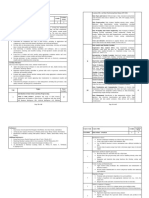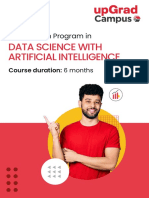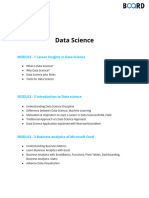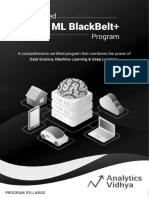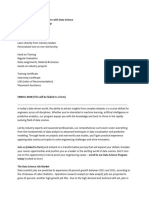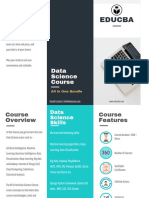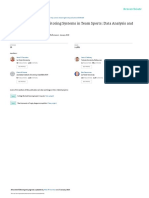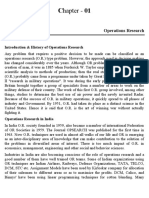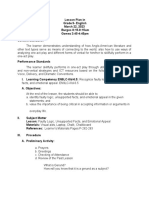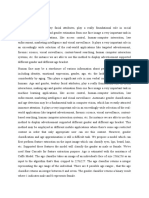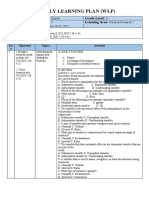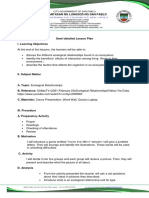Data Science
In the digital age, data is one of the most valuable assets an organization can possess. The Data Science course is
designed to equip professionals with the skills, tools, and methodologies required to extract meaningful insights from
complex datasets and apply them to solve real-world problems. This comprehensive course covers the full data science
lifecycle, from data acquisition and cleaning to modeling, visualization, and communication of results.
Participants will explore a broad range of data science techniques, including statistical analysis, data wrangling, machine
learning, and predictive modeling. The course provides a strong foundation in using programming tools such as Python
or R, and emphasizes hands-on learning through real datasets and applied exercises. Whether dealing with structured or
unstructured data, students will learn how to identify patterns, uncover trends, and build models that generate
actionable intelligence.
This course also highlights the importance of data visualization and storytelling, teaching participants how to translate
complex analyses into compelling narratives that support strategic decision-making. Participants will create interactive
dashboards and visual reports using tools such as Tableau, Power BI, or Python libraries like Matplotlib and Seaborn.
Ethics and data governance are also addressed, ensuring learners understand the responsibilities that come with
handling sensitive information. Topics such as data privacy, model fairness, bias mitigation, and explainable AI are
covered to promote responsible and trustworthy data practices.
The course is suitable for aspiring data scientists, analysts, business professionals, and technical staff who want to
develop a deep understanding of data-driven problem solving. It is structured to support both newcomers to data
science and those looking to formalize and expand their analytical capabilities.
By the end of the course, participants will have developed the confidence to independently manage data projects—from
asking the right questions to delivering insights that drive value. They will be prepared to apply data science techniques
in domains such as marketing, finance, healthcare, logistics, and beyond.
Whether you are building predictive models, optimizing operations, or enabling smarter business strategies, Data
Science is the essential skillset for leading in the era of digital transformation.
�Learning objectives
By the end of this course, participants will be able to:
• Understand the complete data science lifecycle from data acquisition to insight delivery.
• Use programming languages such as Python or R for data manipulation and analysis.
• Clean, transform, and prepare structured and unstructured data for analysis.
• Apply statistical methods and machine learning algorithms to derive predictive insights.
• Visualize data effectively and create compelling dashboards and reports.
• Communicate analytical findings to technical and non-technical audiences.
• Work with databases, APIs, and cloud-based data sources.
• Develop and evaluate machine learning models using best practices.
• Address ethical, privacy, and bias considerations in data science projects.
• Deploy data science solutions in real-world business or operational contexts.
�Module 1: Introduction to Data Science
• Definition, roles, and applications
• Data science vs. analytics vs. AI
Module 2: Data Collection and Preparation
• Data sources: APIs, databases, web scraping
• Data cleaning and preprocessing techniques
Module 3: Exploratory Data Analysis (EDA)
• Descriptive statistics and visual analysis
• Detecting patterns, outliers, and anomalies
Module 4: Programming for Data Science
• Python or R fundamentals
• Key libraries: Pandas, NumPy, Scikit-learn, etc.
Module 5: Data Visualization and Reporting
• Chart types and storytelling with data
• Tools: Tableau, Power BI, Matplotlib, Seaborn
Module 6: Statistical Inference and Probability
• Distributions, sampling, and hypothesis testing
• Confidence intervals and p-values
Module 7: Machine Learning Basics
• Supervised vs. unsupervised learning
• Regression, classification, clustering
Module 8: Model Building and Evaluation
• Training/testing split, cross-validation
• Accuracy, precision, recall, AUC
Module 9: Working with Big Data and Cloud Tools
• Introduction to SQL, NoSQL
• Overview of cloud data services (AWS, GCP, Azure)
Module 10: Ethics, Bias, and Responsible AI
• Data privacy and GDPR considerations
• Avoiding algorithmic bias and ensuring transparency




